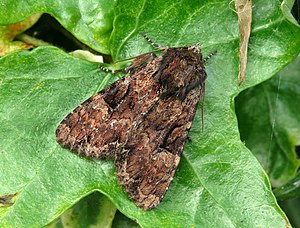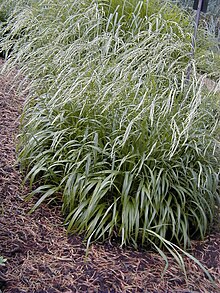Blemish-edged tussock owl
| Blemish-edged tussock owl | ||||||||||||
|---|---|---|---|---|---|---|---|---|---|---|---|---|

Blemish-edged tufted owl ( Apamea epomidion ) |
||||||||||||
| Systematics | ||||||||||||
|
||||||||||||
| Scientific name | ||||||||||||
| Apamea epomidion | ||||||||||||
| ( Haworth , 1809) |
The blemish-edged grass-tufted owl ( Apamea epomidion , synonyms : Hadena hepatica or Apamea characterea ), sometimes also referred to as the Waldzwenkenflur-grass owl , is a butterfly ( moth ) from the family of the owl butterflies (Noctuidae).
features
butterfly
The wingspan of the moth is 35 to 48 millimeters. The basic color of the upper side of the forewings varies from yellow-brown to red-brown to dark brown. Kidney and ring flaws are usually clearly developed. The ring flaw is outlined in black on three sides and only open to the front edge. A strong indentation of the wavy line is noticeable. The upper side of the hind wings is a single color, light gray-brown.
Caterpillar
Adult caterpillars are light gray to reddish brown in color. They show a yellow-white topline. On each body segment there are black point warts and also black stigmas . The side stripe is yellow-white to gray. The head capsule is glossy brown, the pronotum and anus are black-brown. Two light vertical stripes stand out from the pronotum.
Similar species
In the butterflies of the great variable grass tufted owl ( Apamea crenata ), the ring blemish has a whitish or brown border.
distribution and habitat
The distribution of the species extends through Europe and north Asia to east Siberia . In the Alps it is absent at higher altitudes. The Makelrand grass tufted owl prefers to live in light forest areas and grassy slopes.
Way of life
The moths are nocturnal. They fly in a generation from June to August and visit artificial light sources as well as bait . The caterpillars live mainly from August, overwinter and pupate in April or May of the following year. The young caterpillars sit in the inflorescences, the older ones rest on the ground during the day and come up to feed at night. They prefer to feed on the seeds or stalks of various grasses , primarily forest dwarfs ( Brachypodium sylvaticum ), sometimes also forest fescue ( Festuca altissima ), creeping couch grass ( Elymus repens ), annual bluegrass ( Poa annua ) or Reed ( Phragmites ). Rubus species are also mentioned as food plants .
Danger
The Makelrand grass tufted owl is widespread in Germany and is listed as "not endangered" on the Red List of Endangered Species in the southern federal states. However, in some northern and central regions it is classified as “critically endangered”.
Individual evidence
- ^ Alberto Zilli, László Ronkay, Michael Fibiger: Apameini. In: WG Tremewan (Ed.): Noctuidae Europaeae. 1st edition. Volume 8. Entomological Press, Sorø 2005, ISBN 87-89430-09-3 , pp. 118-120
- ↑ Markku Savela: distribution. In: Lepidoptera and some other life forms. Retrieved January 10, 2020 .
- ↑ a b c Günter Ebert (Ed.): The butterflies of Baden-Württemberg. 1st edition. Volume 6. Moths IV. Noctuidae 2nd part. Ulmer, Stuttgart (Hohenheim) 1997, ISBN 3-8001-3482-9 , pp. 571-574
- ↑ Walter Forster, Theodor A. Wohlfahrt: The butterflies of Central Europe. Volume 4: Owls. (Noctuidae). Franckh'sche Verlagshandlung, Stuttgart 1971, ISBN 3-440-03752-5 , p. 126
- ↑ Manfred Koch: We identify butterflies. Volume 3: Owls. 2nd, expanded edition. , Neumann Verlag, Leipzig / Radebeul, 1972, pp. 164/165
- ↑ www.schmetterlinge-deutschlands.de, Occurrence and endangerment in Germany
literature
- Alberto Zilli, László Ronkay, Michael Fibiger: Apameini. In: WG Tremewan (Ed.): Noctuidae Europaeae. 1st edition. Volume 8. Entomological Press, Sorø 2005, ISBN 87-89430-09-3
- Günter Ebert (Ed.): The butterflies of Baden-Württemberg. 1st edition. Volume 6. Moths IV. Noctuidae 2nd part. Ulmer, Stuttgart (Hohenheim) 1997, ISBN 3-8001-3482-9
- Walter Forster, Theodor A. Wohlfahrt: The butterflies of Central Europe. Volume 4: Owls. (Noctuidae). Franckh'sche Verlagshandlung, Stuttgart 1971, ISBN 3-440-03752-5
Web links
- Lepiforum e. V. - Taxonomy and photos
- pyrgus.de - Butterflies and their ecology
- leps.it - Moths and Butterflies of Europe and North Africa
